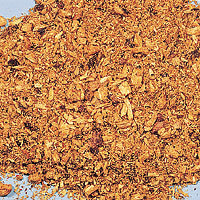Lomatium
Uses
Parts Used & Where Grown
Lomatium is native to western North America. Lomatium is potentially threatened in some parts of its habitat, so it should not be picked from the wild without consulting local experts familiar with the plant. The root of lomatium is used medicinally.
Our proprietary “Star-Rating” system was developed to help you easily understand the amount of scientific support behind each supplement in relation to a specific health condition. While there is no way to predict whether a vitamin, mineral, or herb will successfully treat or prevent associated health conditions, our unique ratings tell you how well these supplements are understood by the medical community, and whether studies have found them to be effective for other people.
For over a decade, our team has combed through thousands of research articles published in reputable journals. To help you make educated decisions, and to better understand controversial or confusing supplements, our medical experts have digested the science into these three easy-to-follow ratings. We hope this provides you with a helpful resource to make informed decisions towards your health and well-being.
3 Stars Reliable and relatively consistent scientific data showing a substantial health benefit.
2 Stars Contradictory, insufficient, or preliminary studies suggesting a health benefit or minimal health benefit.
1 Star For an herb, supported by traditional use but minimal or no scientific evidence. For a supplement, little scientific support.
This supplement has been used in connection with the following health conditions:
| Used for | Why |
|---|---|
|
1 Star
Infection
Refer to label instructions
|
Lomatium is an herb that directly attack microbes.
Herbs that directly attack microbes include the following: chaparral, eucalyptus, garlic, green tea, lemon balm (antiviral), , myrrh, olive leaf, onion, oregano, pau d’arco (antifungal), rosemary, sage, sandalwood, St. John’s wort, tea tree oil, thyme, and usnea. |
Traditional Use (May Not Be Supported by Scientific Studies)
Native Americans of many tribes reportedly used lomatium root to treat a wide variety of infections, particularly those affecting the lungs.1 Lomatium was used, particularly in the southwestern United States, during the influenza pandemic of 1917 with reportedly good results.
How It Works
How It Works
According to obscure sources, lomatium is reputed to have antiviral effects. One source suggests the constituents tetronic acids and a glucoside of luteolin may be potentially antiviral.2 However, little is known about how these compounds act or if other ones might be as important.
How to Use It
Lomatium extracts with the resins removed (often called lomatium isolates), 1–3 ml per day, have been recommended. Lomatium tincture, 1–3 ml three times per day, can also be used, but it may cause a rash in susceptible people. The tincture should not be used unless a very small amount of it is first tested for a reaction. However, even very small amounts can cause a reaction in sensitive people.
Interactions
Interactions with Supplements, Foods, & Other Compounds
Interactions with Medicines
Side Effects
Side Effects
Use of lomatium extracts or tinctures containing the resin (and possibly the coumarins) can, in some people, cause a whole-body rash.3 This herb may also lead to nausea in some people. The safety of lomatium during pregnancy and breast-feeding is unknown and is therefore not recommended.
References
1. Moore M. Medicinal Plants of the Pacific West. Santa Fe: Red Crane Books, 1993, 61-71.
2. Vanwagenen BC, Cardellina JH. Native American food and medicinal plants. 7. Antimicrobial tetronic acids from Lomatium dissectum. Tetrahedron 1986;42:1117.
3. Moore M. Medicinal Plants of the Pacific West. Santa Fe: Red Crane Books, 1993, 61-71.
Last Review: 03-24-2015

Copyright © 2025 TraceGains, Inc. All rights reserved.
Learn more about TraceGains, the company.
The information presented by TraceGains is for informational purposes only. It is based on scientific studies (human, animal, or in vitro), clinical experience, or traditional usage as cited in each article. The results reported may not necessarily occur in all individuals. For many of the conditions discussed, treatment with prescription or over the counter medication is also available. Consult your doctor, practitioner, and/or pharmacist for any health problem and before using any supplements or before making any changes in prescribed medications. Information expires December 2025.



